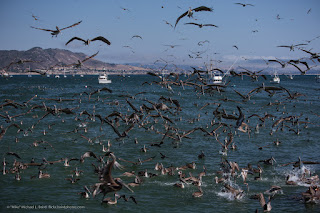Met up with Harry and Norma Catchpole at Shamel Park in Cambria. The first bird of the day was a Spotted Sandpiper. It's cute little rump bobbed up and down as it walked along the edge of the narrow Santa Rosa Creek Lagoon. Four Great Egrets were roosting in the willows that lined the creek. Over the sea, Brown Pelican flew. No doubt about it, we were going to have a great day of birding. (above photo - San Simeon State Beach) (below photo - Harry & Norma at Santa Rosa Creek)

The lagoon was shallow; along the edges lay a thick layer of algae. Immediately, sharp eyed Harry spotted a Black-necked Stilt with a broken leg. The Stilt was able to fly and appeared to have no difficulty feeding. While looking for the Ibis we watched, a sub-adult or first year Peregrine Falcon Bathing; now that was a treat. As we continued watching, three Turkey Vultures landed close to the Falcon. We were quite sure we heard the Peregrine say, “too close for comfort,” as she flew north.
As we walked along the edge of the lagoon looking for the Ibis or anything with wings, we were amazed by a Great Blue Heron who was not in the least bit bothered by our presence.
Besides Mallards and Coots, the only birds we noticed were Killdeer, a Spotted Sandpiper and a Great and Snowy Egret. Giving up on the Ibis search we headed over the beach to the water's edge. Not wanting to waste a birding moment, we looked for Snowy Plover as we trudged through the gravely sand. Yeah, we spotted two of the little darlings. When not moving the Snowy Plover tends to be invisible. (below photo - Snowy Plover)
Along the edge of the water, a mixed flock of Whimbrel, Willet, Godwit, Long-billed Curlew, and one lonely Black-bellied Plover. Missing from the beach were Gulls and Terns.
Located at the south end of the boardwalk is a small bridge over San Simeon Creek. Willow branches dip into the still water - a perfect habitat for Green Heron. It took us awhile to locate the Green Heron, as it was in the shade and bent over the water. While we watched it snag a fish with its stiletto like bill, a King Fisher was dashing back and forth across the peaceful creek.
Before lunch, which is always an important part of the day, we wanted to check out the bird activity from San Simeon Pier. At a distance we saw a small collection of Common Murre, and fortunately, one Murre very close to the pier, which allowed us an intimate view of the little darling. Out to sea were thousands of Shearwater, flying by in a stream were Brown Pelican.Resting on the shore was a small flock of Elegant Tern. While we were looking at them, a Peregrine Falcon swooped down, causing them to take flight. The powerful Peregrine took after one of the Terns. Repeatedly, the Peregrine dove on the Tern, talons ready to grab on to its victim. Feathers flew, and by some miracle the Peregrine accepted defeat and flew off.
Thought for the day - One Good Tern Deserves Another
On the 8/24 blog, http://birdingthecentralcoast.blogspot.com/2015/08/morro-bay-return-of-sandpipers.html The question - "How many Dunlin do you see in the photo? Are the smaller birds Western or Least Sandpiper" The answer - 9 Dunlin and Western Sandpiper.






